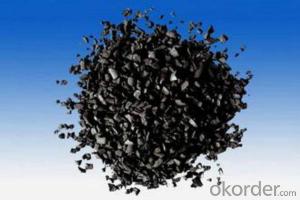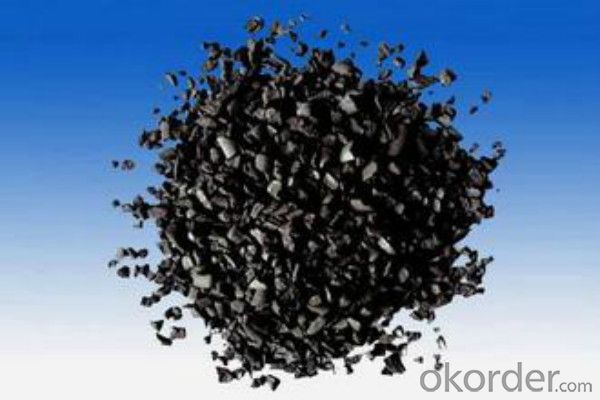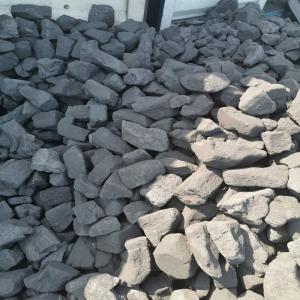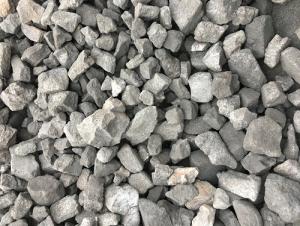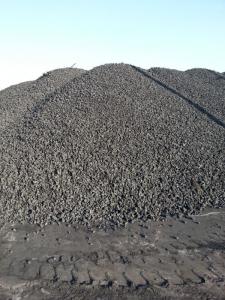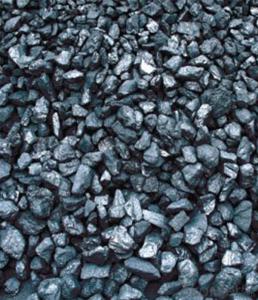Low Sulfur Coal Met Coke Manufactured in High Quality
- Loading Port:
- Tianjin
- Payment Terms:
- TT OR LC
- Min Order Qty:
- 900 m.t.
- Supply Capability:
- 15000 m.t./month
OKorder Service Pledge
OKorder Financial Service
You Might Also Like
Product Description
Met Coke(metallurgical coke) is a carbon material resulting from the manufactured purification of multifarious blends of bituminous coal. In its natural form, bituminous coal is soft;
Features
It is widely used in casting and metallurgy Smelting every tons Irons need about 0.4 to 0.6ton coke. As the reducing agent in the steel-making and foundry industry. It is playing more and more important role in the steel industry
Specification
Item No. | Ash (%) max | S (%) max | F.C. (%) min | V.M (%) max | Moisture (%) max | P (%) max | CSR (%) min | CRI (%) max | Cal.Value (≥Kcal/Kg) |
NF-M001 | 9 | 0.6 | 89.5 | 1.2 | 5 | 0.035 | 65 | 25 | 7250 |
NF-M002 | 10.5 | 0.6 | 88 | 1.2 | 5 | 0.035 | 65 | 25 | 7100 |
NF-M003 | 12 | 0.6 | 86.5 | 1.5 | 5 | 0.035 | 63 | 28 | 6900 |
NF-M004 | 13 | 0.6 | 85.5 | 1.5 | 5 | 0.035 | 60 | 30 | 6800 |
Pictures

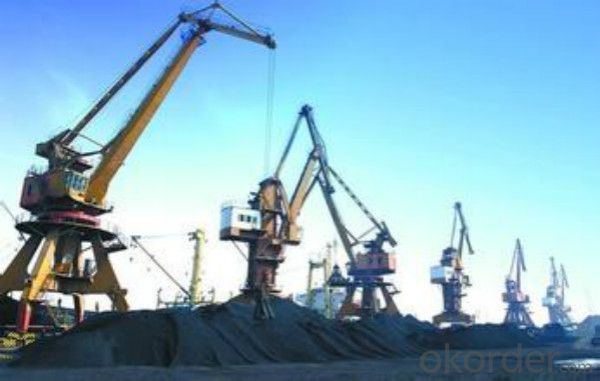
FAQ
1 What is the packing?
Packaging Details: | 1. jumbo ton bag |
2 Delivery time? Delivery Detail: |
15 days after we get the advanced payment or original L/C |
- Q: What are the impacts of carbon emissions on human respiratory diseases?
- Carbon emissions, particularly those from burning fossil fuels, have significant impacts on human respiratory diseases. The release of carbon dioxide and other greenhouse gases into the atmosphere contributes to climate change, which in turn affects air quality and worsens respiratory conditions. One of the main consequences of carbon emissions is the increase in air pollution. Fossil fuel combustion releases various pollutants, such as nitrogen oxides, sulfur dioxide, and particulate matter, which can irritate and damage the respiratory system. These pollutants can trigger and exacerbate respiratory diseases such as asthma, bronchitis, and chronic obstructive pulmonary disease (COPD). They can also lead to the development of respiratory infections and reduce lung function, making individuals more susceptible to respiratory illnesses. Climate change, driven by carbon emissions, also worsens respiratory health. Rising temperatures and changing weather patterns contribute to the proliferation of allergens and air pollutants, leading to more frequent and severe allergic reactions and exacerbations of respiratory conditions. Additionally, climate change can extend the pollen season and increase the production of mold spores, triggering asthma attacks and other respiratory symptoms. Furthermore, carbon emissions contribute to the formation of ground-level ozone, a harmful pollutant. Higher temperatures and increased sunlight due to climate change promote the chemical reactions that produce ozone. Ground-level ozone can irritate the airways, causing coughing, shortness of breath, and chest pain. It can also worsen existing respiratory diseases and impair lung function, particularly in vulnerable populations such as children, the elderly, and people with pre-existing respiratory conditions. In summary, carbon emissions have profound impacts on human respiratory diseases. They contribute to air pollution, which aggravates respiratory conditions and increases the risk of respiratory infections. Additionally, climate change, driven by carbon emissions, intensifies the production of allergens and air pollutants, exacerbating respiratory symptoms and reducing lung function. Taking effective measures to reduce carbon emissions is crucial not only for mitigating climate change but also for safeguarding respiratory health.
- Q: How is carbon used in the production of ink?
- Carbon is used in the production of ink in various forms, such as carbon black or activated carbon. Carbon black is a fine black powder that is derived from the incomplete combustion of petroleum products. It is commonly used as a pigment in inks to provide a deep black color. Carbon black particles are small and have a high surface area, which allows them to disperse evenly in the ink and provide a consistent color. Activated carbon, on the other hand, is a highly porous form of carbon that is produced by heating carbonaceous materials, such as wood or coconut shells, at high temperatures. It is used in ink production as a filter or purification agent. Activated carbon has a large surface area with numerous microscopic pores, which enable it to adsorb contaminants, impurities, and unwanted substances from the ink. This helps improve the quality and stability of the ink, ensuring a smooth and consistent flow. In addition to its use as a pigment and a purification agent, carbon is also utilized in ink production as a conductive material. Carbon-based inks are commonly used in applications that require electrical conductivity, such as printed circuit boards, sensors, or electronic devices. These inks contain carbon particles dispersed in a liquid medium, allowing them to be printed or deposited onto a substrate to create conductive pathways. Overall, carbon plays a crucial role in the production of ink by providing color, acting as a purification agent, and enabling electrical conductivity. Its versatile properties and wide range of applications make it an essential component in the ink manufacturing process.
- Q: What are the different types of carbon steel?
- Carbon steel, known for its strength, durability, and affordability, is widely utilized in various industries. It is a versatile material with multiple types, each possessing unique properties and applications. 1. Low Carbon Steel: This form of carbon steel contains a minimal amount of carbon, usually up to 0.25%. It is extensively used due to its affordability, ease of fabrication, and weldability. Low carbon steel finds applications in construction, automotive manufacturing, and general engineering. 2. Medium Carbon Steel: With a carbon content ranging from 0.25% to 0.60%, medium carbon steel offers increased strength and hardness compared to low carbon steel. It is commonly employed in machinery parts, axles, gears, and shafts that require enhanced toughness and wear resistance. 3. High Carbon Steel: High carbon steel contains a carbon content of 0.60% to 1.00%. It possesses excellent strength and hardness but is less ductile and more brittle than low and medium carbon steels. High carbon steel is frequently used in cutting tools, springs, and high-strength wires. 4. Ultra-High Carbon Steel: This type of carbon steel contains a carbon content exceeding 1.00%, typically ranging from 1.20% to 2.50%. It exhibits extremely high hardness and is often employed in specialized applications such as knives, blades, and tools that demand exceptional sharpness and wear resistance. 5. Carbon Tool Steel: Carbon tool steel refers to a group of steels that incorporate additional alloying elements like chromium, vanadium, or tungsten. These alloying elements enhance the steel's hardness, wear resistance, and heat resistance, making it suitable for tool and die making, cutting tools, and molds. It is important to note that the strength, hardness, and other properties of steel are determined by its carbon content. The selection of the appropriate type of carbon steel depends on the specific application, desired characteristics, and manufacturing requirements.
- Q: Are carbon cells the same as alkaline batteries?
- Carbon battery is not only suitable for the flashlight, radios, tape recorders, cameras, semiconductor, electronic clocks, toys and other fields, but also for national defense, scientific research, telecommunication, navigation, aviation, medicine, etc. in the national economy. Carbon battery is mainly used for low power electrical appliances, such as watches, wireless mouse such as electrical appliances should use alkaline batteries, such as the camera, the camera also hold some basic, it needs to use nimh.Alkaline batteries, also known as alkaline dry cells, alkaline manganese dioxide batteries and alkaline manganese batteries, are among the best in the range of zinc manganese batteries. The utility model is suitable for large discharge capacity and long time use.
- Q: What are the applications of carbon nanomaterials in medicine?
- Carbon nanomaterials have emerged as promising tools in the field of medicine due to their unique properties and potential applications. One of the key applications of carbon nanomaterials in medicine is in drug delivery systems. These nanomaterials can be functionalized with drugs, making them capable of targeted delivery to specific cells or tissues. The large surface area of carbon nanomaterials allows for more efficient drug loading, enabling improved therapeutic efficacy and reduced side effects. Carbon nanomaterials also show great potential in the field of tissue engineering. They can be used as scaffolds to support the growth and regeneration of damaged tissues. Carbon nanomaterials possess excellent mechanical strength and biocompatibility, making them suitable for applications such as bone and cartilage repair. Additionally, their electrical and thermal conductivity properties make them ideal for creating bioelectrodes and biosensors, which can be used for various diagnostic and monitoring purposes. Furthermore, carbon nanomaterials have been explored for their antimicrobial properties. They have shown the ability to inhibit the growth of bacteria and fungi, making them potential candidates for developing new antimicrobial agents. This could be particularly useful in preventing and treating infections in medical devices and implants. Another application of carbon nanomaterials in medicine is in imaging and diagnostics. These nanomaterials can be used as contrast agents in various imaging techniques, such as magnetic resonance imaging (MRI) and fluorescence imaging. Their unique optical and magnetic properties allow for enhanced imaging and improved detection of diseases, such as cancer. Carbon nanomaterials also hold promise in the field of cancer therapy. They can be used in photothermal therapy, where the nanomaterials are exposed to light, converting it into heat and selectively killing cancer cells. Additionally, carbon nanomaterials can be used in photodynamic therapy, where they generate reactive oxygen species upon light activation, leading to cancer cell destruction. In summary, carbon nanomaterials have a wide range of applications in medicine. They offer the potential for targeted drug delivery, tissue engineering, antimicrobial agents, diagnostic imaging, and cancer therapy. Continued research and development in this field hold great promise for revolutionizing medical treatments and improving patient outcomes.
- Q: Emerald garden high carbon tempered metal
- 2.1 businessmen in the lower right corner. After 2.2, on an island below. Go and eat the merchant and bring him home. Kill the dragon. Be sure to hurry. The merchant fell off (I don't recommend it). You can also put a red dragon below killed off 2 Dragon eggs. Called red dragon, the businessman to eat, then at home, do not ignore it, he died, a businessman has come out. Get around the enemy base!
- Q: How is carbon used in the production of graphite?
- Carbon is a key component in the production of graphite. Graphite is a crystalline form of carbon with a unique structure that gives it its distinctive properties. To produce graphite, carbon is subjected to extreme heat and pressure, which causes the carbon atoms to rearrange into layers of hexagonal rings. These layers are stacked on top of each other, forming the graphite's characteristic layered structure. The process begins with a high-quality carbon source, such as petroleum coke or coal tar pitch. These carbon sources are first heated to very high temperatures to eliminate impurities and convert them into a pure carbon material called coke. The coke is then ground into a fine powder and mixed with a binder, usually a form of pitch, to form a paste. This paste is then shaped into the desired form, such as rods or blocks, and subjected to high temperatures in a furnace. The heat causes the binder to decompose and the carbon atoms to rearrange into the hexagonal layers that are characteristic of graphite. The high pressure present in the furnace helps to align the carbon layers, resulting in the formation of graphite crystals. After the furnace process, the graphite is further purified through a series of treatments, including chemical washing and acid leaching, to remove any remaining impurities. Finally, the purified graphite is shaped into the desired final product, such as pencils, electrodes, or lubricants, through processes like extrusion or machining. In summary, carbon is used in the production of graphite by subjecting a carbon source to high temperatures and pressures, resulting in the formation of graphite crystals with its unique layered structure. This process allows for the production of various graphite products that are widely used in industries such as manufacturing, electronics, and energy.
- Q: What is carbon nanotube?
- Carbon nanotubes are cylindrical structures made up of carbon atoms arranged in a unique hexagonal lattice pattern. They are incredibly small, with diameters on the nanometer scale (about 1 billionth of a meter) and lengths that can range from a few nanometers to several centimeters. Carbon nanotubes possess remarkable properties that make them highly attractive for a wide range of applications. They are incredibly strong, with tensile strength that exceeds that of any other known material, making them ideal for use in structural composites. They also have excellent electrical conductivity, thermal conductivity, and are chemically stable, which makes them useful in fields such as electronics, energy storage, and catalysis. There are two main types of carbon nanotubes: single-walled nanotubes (SWNTs) and multi-walled nanotubes (MWNTs). Single-walled nanotubes consist of a single layer of carbon atoms rolled into a tube, while multi-walled nanotubes consist of multiple concentric layers of carbon atoms. The arrangement of carbon atoms and the diameter of the tube determine the properties of the nanotube. Carbon nanotubes have the potential to revolutionize various industries due to their unique properties. They are being explored for applications in electronics, where they can be used as high-performance transistors, interconnects, and sensors. They also hold promise in the field of energy storage, as they can be used in batteries and supercapacitors that have higher energy densities and faster charging rates. Additionally, their high surface area and unique chemical properties make them suitable for catalytic applications, such as water purification and chemical synthesis. Despite their immense potential, there are still challenges to overcome in the large-scale production and commercialization of carbon nanotubes. However, ongoing research and development efforts continue to push the boundaries of their applications, making carbon nanotubes an exciting field of study with significant future possibilities.
- Q: What is carbon black rubber?
- Carbon black rubber, which incorporates carbon black as an additive, is a variant of rubber. Carbon black, a finely divided form of carbon generated from the incomplete combustion of hydrocarbon fuels, is utilized in rubber compounds to enhance their mechanical characteristics, including tensile strength, abrasion resistance, and resilience. Within the rubber matrix, the carbon black particles are evenly dispersed, serving to reinforce the material and amplify its durability and performance. Carbon black rubber finds extensive application in the manufacturing of tires, conveyor belts, gaskets, seals, as well as a range of automotive and industrial rubber goods.
- Q: What is sintered carbon?
- The process of choosing appropriate process and operating systems in accordance with the internal laws of the sintering process, the use of modern scientific and technological achievements, strengthening sintering production process, to obtain advanced technical and economic indicators, to ensure the realization of high yield, high quality and low consumption. The production process has the raw materials, against the ash, mixing, crushing and screening, crushing and screening solvent fuel proportioning, mixing, ignition, exhaust ventilation cooling, sintering, crushing and screening, dust and other aspects.
Send your message to us
Low Sulfur Coal Met Coke Manufactured in High Quality
- Loading Port:
- Tianjin
- Payment Terms:
- TT OR LC
- Min Order Qty:
- 900 m.t.
- Supply Capability:
- 15000 m.t./month
OKorder Service Pledge
OKorder Financial Service
Similar products
Hot products
Hot Searches
